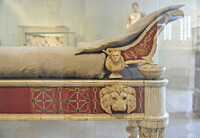Couch and footstool with bone carvings and glass inlays
unknown (Ancient Roman)

Download7A3-MMA-R-CF-A03_cp.jpg (355.7Kb)
Alternate file
Alternative Title
Roman couch and footstool
Date
10-199Description
Detail of curved end (for reclining) with bone carvings including lion head with inset glass eyes; These pieces of furniture have been reassembled from fragments, some of which may come from the imperial villa of Lucius Verus (co-emperor, 161-169 CE), on the Via Cassia outside Rome. It is not certain that the square glass panels are original to the bed frame and stool, but the carved bone inlays are paralleled on other Roman couches. On the couch legs are friezes of huntsmen, horses, and hounds flanking Ganymede, the handsome Trojan youth who was abducted by Zeus in the guise of an eagle to serve as his wine steward; on the footstool are scenes of winged cupids and leopards; and on the sides of the bed frame, the striking lion protomes have eyes inlaid with glass. [The furniture was once displayed in the reconstructed cubiculum of of Fannius Synistor at the museum but is now displayed separately since they are not related. The couch may have been used for dining rather than sleeping.] Source: Metropolitan Museum of Art [website]; http://www.metmuseum.org (accessed 4/30/2014)
Type of Work
couch (reclining furniture); footstool (stool)Subject
animal, decorative arts, mythology (Classical), Roman Empire, Imperial (Roman)
Rights
Rights Statement
Licensed for educational and research use by the MIT community only